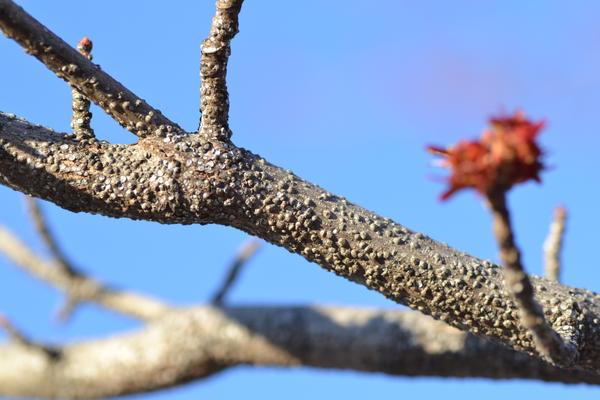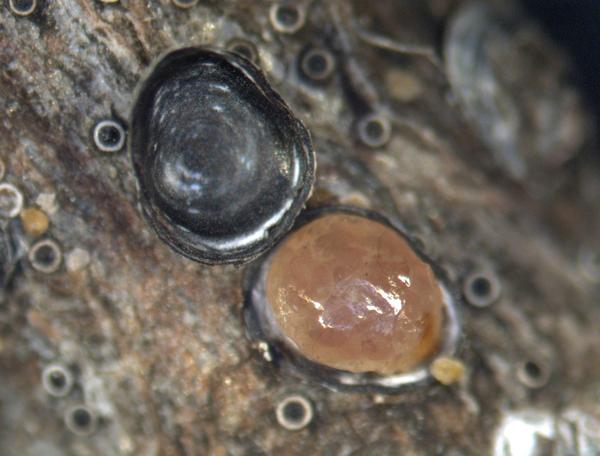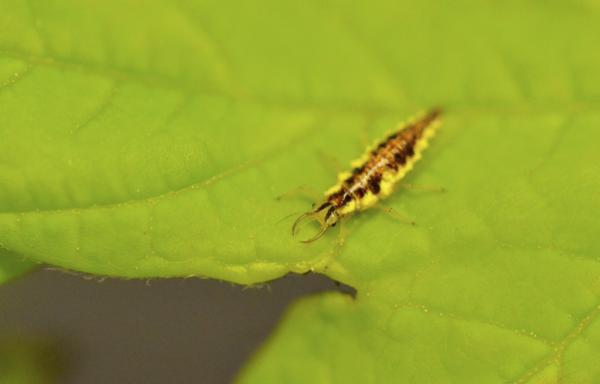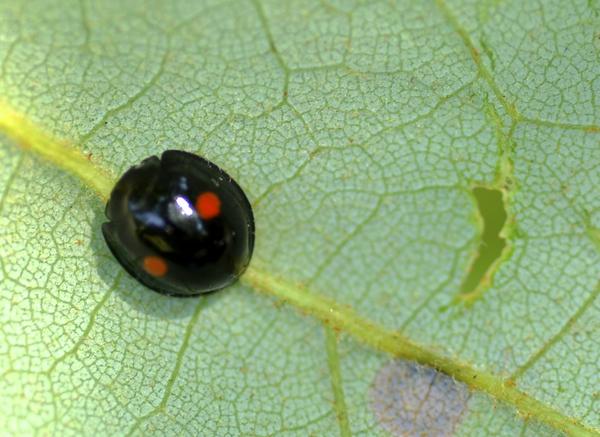Identification and Damage
Gloomy scale is primarily a pest of red maples but has been observed feeding on other tree species including sugar maple, elm, tulip poplar, hackberry, boxelder, buckthorn, sweet gum, gallberry, mulberry, native hollies, and soapberry. Gloomy scale is found throughout the southeastern United States as far north as Maryland, south to Florida, and west to Texas. They are more abundant on trees in cities than in natural areas. Adult female covers, called tests, are up to 2 millimeters wide with a central pale ring. The test is convex and can be grey to brown and blends in with the bark. Beneath the test the soft-bodied scale insect is pink, legless, and wingless. Males are smaller, have an oval shaped armored covering, and develop legs and wings as an adult. The nymphs, called crawlers, are less than 1mm and orange. The young female nymphs resemble adults but have significantly smaller bodies and armor.
Gloomy scales use their piercing-sucking mouthparts to penetrate the tree bark and feed on parenchyma cells, which synthesize and store organic products within the tree. This damages the tree by robbing it of nutrients and energy necessary to grow. Damage may also be caused by toxins in saliva that are injected while feeding. Heavily infested trees will exhibit twig and branch dieback, thinning canopy, and eventual death. The bark of heavily infested trees will darken and have a bumpy texture due to scale insect covers.
Biology
Gloomy scales overwinter as mated adult females. Development resumes in the spring and crawlers (immatures) emerge from their mothers for 6-8 weeks beginning in early May. Crawlers emerge from under the adult female’s cover and search for a suitable feeding site. Once the crawler has inserted its mouthparts, it will tuck in its legs and antennae and begin secreting the test. After the scale molts it will not have legs or antennae. During subsequent molting, the males will molt into ‘prepupae’ and ‘pupae’, stages in which the legs and wings develop once again. In August, the males emerge to mate with adult females. There is one generation per year.
Scouting and Monitoring
Scouting can be done anytime of year to identify infested trees since they have a one-year life cycle. Scale tests remain attached to trees even after the scales die. Thus, it is important to be sure scales are alive before any intervention. Flip the test up to look for live pink females or scrape the scales to look for pink or yellow juices that indicate live scales. Dry, flaky tests are from dead scales. In May and June, check the tree bark for crawlers and nymphs or use tape (sticky side out) wrapped around a branch to determine when crawlers are active. In lightly infested trees, look for gloomy scales near twig crotches and buds. Once scale populations increase, whole stem surfaces may become covered in multiple layers of scales.
Decision Making
There are no established aesthetic or economic thresholds for when gloomy scale intervention is necessary. Consider site characteristics to help predict if scales will become abundant. Trees in hot sites surrounded by impervious surfaces (buildings, roads, parking lots) are likely to become heavily infested because the heat increases scale insect reproduction and tree stress. Scales may persist at low densities on trees in more vegetationally complex, cooler landscapes and never need intervention.
Intervention
Cultural Control
Prevent gloomy scale infestations and long-term management by selecting correct planting sites for red maples. Trees planted near large amounts of impervious surfaces are more prone to gloomy scale infestation and subsequent damage. Impervious surfaces reduce water availability and increase soil and air temperatures. Gloomy scale becomes more abundant as tree canopy temperature and drought stress increase. When planting red maples, be conscious of the surrounding landscape and avoid planting in areas with greater than 60% impervious surface. Research has shown that reducing plant stress by proper planting and watering can reduce susceptibility to infestation and damage by gloomy scale. Equipment such as Tree Gator® slow-release watering bags can reduce drought stress. However, excessive nitrogen fertilizer may increase scale abundance by making the tree more nutritious to scales and reducing the trees natural defenses.
Biological Control
The most common parasitoid wasps known to attack gloomy scale are in the genera Signiphora, Encarsia, and Ablerus. Other natural enemies such as lacewings, lady beetles, and predacious midges may also provide supplemental control of gloomy scale populations. However, natural enemy control is minimal in urban landscapes either due to warmer temperatures, lack of alternative resources, or lack of vegetation refuges. To maximize potential biological control, provide habitat for natural enemies and reduce temperatures by increasing vegetation cover and complexity around trees.
Mechanical Control
Although there have not been any reported trials with gloomy scale, light to medium infestations of scale insects may be effectively treated with pressure wash applications. High-pressure water sprays can wash scales and scale covers off bark and reduce populations without the need for chemical controls. Make applications when trees are dormant for the winter and make sure the water pressure is not damaging tree bark.
Chemical Control
Chemical control of gloomy scale can take several years to see results and is often expensive. When trees are very heavily infested, consider costs and benefits of treatment compared to tree replacement with another species.
Foliar insecticide applications should coincide with crawler emergence for best control. This is challenging for gloomy scale because crawlers gradually emerge over 6-8 weeks. Therefore, broad-spectrum contact insecticides such as pyrethroids may not be effective and can contribute to the problem by killing natural enemies.
Horticultural oils and dormant oils kill insects by smothering them and breaking down cell membranes. Horticultural oils can also penetrate waxing scale covers. They can be applied during crawler emergence or when trees are dormant to kill overwintering adults. These may be more practical when treating trees that are smaller in size. There is additional information on horticultural oils in Horticultural Oils for Ornmental Plants.
Trunk sprays or soil drenches of systemic insecticides such as dinotefuran and acephate may provide effective, season-long control of many armored scale insects. Acetamiprid is a systemic insecticide that can be applied to foliage. Insect growth regulators such as pyriproxyfen and buprofezin can also provide effective control and are applied to foliage. See current product availability for armored scale management in the North Carolina Agricultural Chemicals Manual.
Other Resources
- Urban warming trumps natural enemy regulation of herbivorous pests. Dale, A. G. and S. D. Frank 2014. Ecological Applications 24:1596–1607.
- Biology, Injury, and Management of Maple Tree Pests in Nurseries and Urban Landscapes. Frank, S. D., W. E. Klingeman, III, S. A. White, and A. Fulcher. 2013. J. Integ. Pest Mngmt. 4(1): 1-14.
- Scales Commonly Encountered in Maryland Landscapes and Nurseries. Gill, Stanton, Shannon Wadkins and Suzanne Klick. 2011 (rev). Univ. of Maryland Ext. Integrated Pest Management for Commercial Horticulture. Fact Sheet - 2011.
- Urban Heat Boosts Some Pest Populations 200-Fold, Killing Red maples. Shipman, M. 2014. NC State News, NC State University.
- Extension Plant Pathology Publications and Factsheets
- Horticultural Science Publications
- North Carolina Agricultural Chemicals Manual
For assistance with a specific problem, contact your local Cooperative Extension Center
Publication date: July 3, 2015
Reviewed/Revised: Nov. 9, 2023
Recommendations for the use of agricultural chemicals are included in this publication as a convenience to the reader. The use of brand names and any mention or listing of commercial products or services in this publication does not imply endorsement by NC State University or N.C. A&T State University nor discrimination against similar products or services not mentioned. Individuals who use agricultural chemicals are responsible for ensuring that the intended use complies with current regulations and conforms to the product label. Be sure to obtain current information about usage regulations and examine a current product label before applying any chemical. For assistance, contact your local N.C. Cooperative Extension county center.
N.C. Cooperative Extension prohibits discrimination and harassment regardless of age, color, disability, family and marital status, gender identity, national origin, political beliefs, race, religion, sex (including pregnancy), sexual orientation and veteran status.






